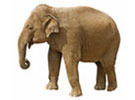Size and Destiny
Part of the The World's Largest Dinosaurs exhibition.
Part of the The World's Largest Dinosaurs exhibition.
A long life means different things to creatures of different sizes and metabolic rates. For a shrew it may be one to three years; for an elephant, 40; for a sauropod dinosaur, perhaps 60. Yet for reasons that experts are still debating, many living animals seem to have roughly the same number of heartbeats over a lifespan.

Shrews are among the smallest living mammals, and they have among the highest heart rates of any animal: about 1,000 beats a minute. Compare that to a young blue whale, at about 20 beats a minute, or 50 times slower.

Experts aren't sure why big animals live longer than small ones. It's clear that size makes big animals safer from predators, but is there something more? The internal engines of big animals "run" more slowly than those of little ones: for example, some shrews' hearts beat as much in a minute as an elephant's heart in half an hour.

The maximum recorded human lifespan--currently upwards of 120 years--is much longer than the maximum predicted for an animal of our size. Even average human lifespan is unexpected; scaling equations suggest a human-sized animal should live between 20 and 25 years.